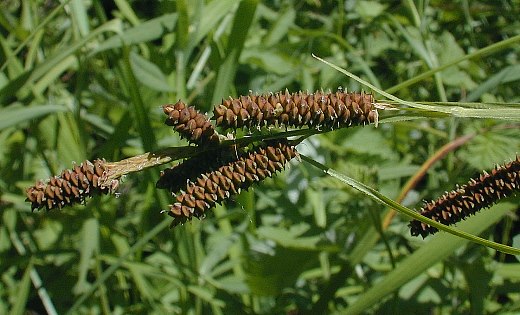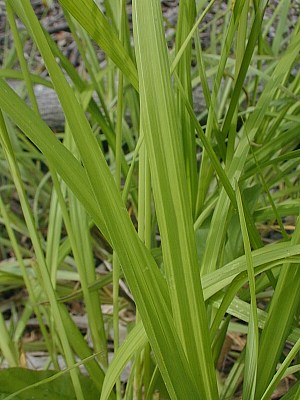Description: This perennial plant is 1½–2½' tall, consisting of tufts of basal leaves and flowering culms with alternate leaves. The culms are light green, hairless, and 3-angled (at least below). The leaves are light green, glabrous, linear, and slightly rough along the margins; they are up to 12" in length and 1/3" across. The longer leaves have a tendency to arch near the middle; the upper surface of each leaf is often indented where the central vein occurs. The culms are unbranched, ascending or erect, and up to 2' long. The cauline leaves of the culms are a little smaller than the basal leaves, otherwise their appearance is quite similar.

Each fertile culm
terminates in an inflorescence consisting of 3-5 spikelets. Each
spikelet is up to 1½" long, ¼" across, and cylindrical in shape. The
uppermost spikelet has pistillate flowers above and staminate flowers
below, while the remaining spikelets have only pistillate flowers. The
scales of the staminate flowers are oblanceolate, while the scales of
the pistillate flowers are ovate; they are both about 3 mm. long. The
perigynia of the pistillate flowers are obovate and somewhat flattened;
they are about 3 mm. long. The perigynia are initially green, but later
become dark brown; they are densely distributed along the length of the
spikelets. Each pistillate flower has a tripartite style. Each spikelet
is short-stalked or sessile. There are one or more slender leafy bracts
near the spikelets. The blooming period occurs during late spring or
early summer. Each pistillate flower produces an obovoid achene that is
3-angled and about 2 mm. long. The root system consists of dark scaly
rhizomes and fibrous roots. This plant often forms vegetative offsets.
Cultivation:
The preference is full to partial sun, moist conditions, and a fertile
loamy soil. Most vegetative growth occurs during the spring. By
mid-summer, the achenes have fallen from the spikelets.

Range & Habitat:
The native Short's Sedge is occasional to locally common in southern
and central
Illinois, while in the northern part of the state it is uncommon to
absent (see Distribution
Map). Habitats include openings in moist deciduous woodlands,
woodland borders, moist prairies (particularly along rivers), sedge
meadows, seeps and fens, low-lying areas along rivers and ponds,
powerline clearances in wooded areas, abandoned fields, and ditches.
This species is typically found in moist meadows near wooded areas and
thickets.
Faunal Associations:
The flowers are pollinated by wind, rather than insects. The
caterpillars of butterflies (Satyrodes spp.),
skippers (Euphyes spp. and others), and moths feed
on Carex spp. (Sedges). See the Lepidoptera
Table for a listing of these species. Some grasshoppers and
other kinds of insects also feed on Carex spp.,
including the following Leafhoppers (Cicadellidae): Cosmotettix
lineatus, Cosmotettix luteocephalus, Cosmotettix
bierni, and Elymana inornata. The seeds
and/or spikelets of Carex spp. are an important
source of food to many kinds of birds, including upland gamebirds,
waterfowl, and songbirds (see the Bird Table for a listing of
these species). The habitat of the particular Carex sp.
determines which birds are likely to use its seeds and/or spikelets.
While the Common Mole primarily eats invertebrates and insects in the
soil, it also eats the roots and rhizomes of Carex spp.
to a limited extent.
Photographic Location:
Along a path near a powerline clearance in Busey Woods, Urbana,
Illinois.
Comments:
The most distinctive feature of Short's Sedge is the dark brown color
of the mature spikelets, which makes this species rather showy during
the early summer. The light green leaves are fairly typical of most Carex
spp. (Sedges). Short's Sedge is a member of a small group of
Sedges that have the staminate flowers underneath the pistillate
flowers on the same spikelet (i.e., it's gynecandrous). This special
arrangement of the flowers is usually restricted to the uppermost
spikelet, while the lower spikelets consist of all pistillate flowers.
The pistillate flowers are densely packed together, which gives the
cylindrical spikelets a grainy appearance.